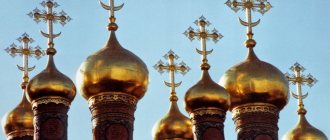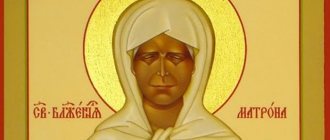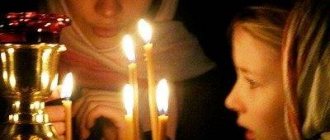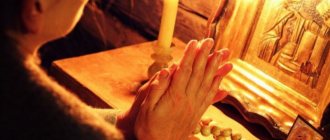Vespers depicts the beginning of human history , the first days of the Fall - the evening (end) of the creation of the world, which for man after the Fall was replaced by a dark night with the deprivation of the sight of the bright Face of God. Matins depicts a joyful and bright morning - the appearance of Christ to the world. And in the second half there is an even brighter morning - the Resurrection of the Lord. The dawn is just beginning to light up in the sky of Bethlehem, the stars have not yet gone out. And here, in the midst of the quiet sky, is the quiet song of the angels: “Glory to God in the highest, on earth peace, good will toward men.” Christ was born - this moment depicts the beginning of Matins (small doxology), a joyful and bright moment, but the time for complete triumph has not yet come. Christ, born on earth, must go through for our sake the sorrowful path of life in the form of a slave and the even more sorrowful path of Golgotha, until he enters into the joy of resurrection and leads us into it. Remembering this, in the silence of the night that has not yet ended, we run, humble, like the shepherds of Bethlehem, to the holy manger with a cry of repentance in the words exapsalmia (six psalms).
It is twilight in the church, so that the fiery words of the psalmist David fall more strongly in the silence and darkness on the heart. The Orthodox Church chose psalms for the Six Psalms of such a nature as to allow those praying to feel as fully and vividly as possible the fallen state of man, to awaken in them feelings of sinfulness and irresponsibility before the judgment of the holiness and truth of God, the fear of eternal death in alienation from the love of God, a living desire and hope of salvation in God, in God's infinite mercy, all-forgiving, cleansing from sins, returning to life from the area of death, reviving with its endless fatherly love. These are psalms: 3, 37, 62, 87, 102 and 142. Like a “burning coal” the fiery words of the prophet fall on a soul disposed to listen and ponder the “songs of repentance”.
Crying at the manger of the Lord about their sins and begging for mercy (both in the psalms and in the great litany following the sixth psalm), believers rejoice over the birth of the Lord: “God is the Lord and has appeared to us, blessed is He who comes in the name of the Lord,” the choir greets the Born One for our salvation Christ. And the troparion of the day, holiday or saint is sung. Then again the holy edifying Psalter. At Sunday matins, the 2nd and 3rd kathismas are always read, because they contain psalms in which the holy prophet David predicts in detail about the suffering and crucifixion of the Savior, the mocking of Him and the division of His clothes by soldiers (Psalm 21), about death, descent into hell and resurrection (psalm 15), victory over hell, destruction of the power of the devil and ascension to heaven (psalm 23). The last psalm is already full of rejoicing. The Lord the Winner opens the doors of heaven, He Himself enters and opens them for His faithful. Open the doors: the King of Glory is coming. Who is this King of Glory? The Lord of Hosts: He is the King of Glory (Ps. 23). And the mood of those praying becomes even brighter.
Next, the 17th kathisma (except for the Lord's holidays and the week of Thomas).
Time and place of Matins in the daily cycle of services
The daily circle, according to the established tradition recorded in the Typikon (the book setting out the liturgical charter), is tied not to astronomical, but to the so-called liturgical time. Thus, the first divine service of the daily circle - Midnight ( Slav Midnight Office) - should The next service is Matins . According to the Typikon, its end coincides with dawn (“Glory to Thee, Lord, who showed us the light!” is the characteristic beginning of the so-called great doxology sung or read at the end of Matins). Next - First Hour , usually performed immediately after Matins, in the first hour of the day beginning at sunrise. The following services of the daily circle are the Third Hour , the Sixth Hour , Fine (essentially , the ancient prayer rule for Holy Communion: among monks at the time when the rules were being formed, the practice of daily cell communion with spare gifts consecrated during the Sunday or holiday Liturgy was widespread; after communion was a meal), the Ninth Hour , Vespers , Compline ( in
Question: Why is it that in most Russian monasteries Matins is performed in the evening immediately after Vespers? What is the liturgical explanation for this tradition and how correct is it?
Answer: Before proceeding directly to the answer, I would like to clarify three points arising from your question. Firstly, we are talking not only about “Russian monasteries”, but about the monasteries of the Russian Orthodox Church, which includes the majority of monasteries in the Republic of Moldova, where almost all of them serve in Romanian. Secondly, I have to disappoint you by clarifying that this statutory anomaly is typical not only for monasteries from this “canonical-liturgical space”, but also for most parishes, especially in cities. For example, in Chisinau there is practically no church where Matins is celebrated in the morning, even in the parishes of the “Bessarabian Metropolis” (Romanian Orthodox Church). Third, I would like to avoid the word “tradition” because we are talking about a relatively new liturgical practice when compared with the two thousand year history of the Church. If we avoid the word “tradition,” this will allow us to approach the issue more critically, and not fanatically and harshly, and not make an idol out of this or that liturgical practice.
Now let’s try to specifically answer each point of the question, which concerns not only the Russian, but also the Romanian Orthodox Churches. And it may turn out that the answer will only be the beginning of a discussion, since this topic seems extremely complex, and within its framework it is impossible to announce final and generally valid decisions.
1. The practice of combining Vespers with Matins is provided for in the Rules of the Monastery of St. Sava in cases where we are talking about “all-night vigils” (agrypnia) on the eve of Sundays and major holidays. (In Russian, this service is called “all-night vigil.” And this sounds all the more ridiculous, since we are talking about a service lasting two to three hours, performed at sunset. For the word “agripnia” in the Romanian language there is a term “priveghere ". As for some Lenten vigils, to designate them, the word “denie” (from “vigil”) was borrowed from Slavic with distortion.)
There are a number of explanations for why monks in Palestine had the custom of performing such “vigils” (You can read about this in detail in the study “Istoria şi rânduiala explicată a Privegherii de sâmbătă seara” / “History and rites with explanations of the All-Night Vigil on Saturday evening”, footnote 10, p. 4). What is important here is that these vigils were not daily. When they were performed, they were literally “all-night vigils” and continued all night, so that Matins ended at sunrise, as stated in the prayers and chants in this part of Matins. That is why the Typikon stipulates that in such cases the Midnight Office is not read, because then the vigil should end with the First Hour, i.e. at the first hour of the day. (In the past, the hours were read at the appropriate time of the day: the first hour - at 6.00, the third hour - at 9.00, the sixth hour - at noon, the ninth hour - at 15.00. The content of their psalms, troparions and prayers corresponds to the time of day when they are read .)
For small holidays or daily services, as is very clearly stated in the Typicon of the Monastery of St. Sava, Matins should be performed in the morning, and all other sequences should be performed in their natural order. In the evening: Ninth Hour, Vespers and Compline, in the morning: Midnight Office, Matins and First Hour, and in the morning: Third and Sixth Hours, Liturgy. Or vice versa: Liturgy, Third and Sixth Hours. (And today, in many monasteries on Athos, the liturgy is celebrated immediately after the First Hour. After this, the monks rest for an hour or two, and then the Third and Sixth Hours are celebrated.) Thus, three cycles are obtained, each of which consists of three elements.
2. If Matins takes place in the evening, long before midnight, and then after that some also eat a meal, then such a “vigil” is not only meaningless, but is also a kind of lie to God and to oneself. We cannot say: “Glory to You, who showed us the Light” when it is dark outside or the sun is barely setting. An honest and conscientious priest cannot thank God for the fact that he “rose from sleep” (see the text of the twelve morning prayers performed during the reading of the Six Psalms.) when he had not yet had dinner and after that he will go to bed.
Thus, by performing Matins in the evening, we are actually serving formally, which is essentially a lie. (In other words, instead of “worship in spirit and truth” - “worship in letter and in untruth.”) The same applies to Vespers performed in the morning (especially during Lent). In addition to this absurdity, the constant celebration of Matins combined with Vespers inevitably leads to a change in the sequence of other services, which turns into a caricature: Ninth Hour - Vespers - Matins - First Hour - dinner - Compline (with the “General Rule” and “evening prayers” ") - sleep - ("morning prayers") - Midnight Office - (prayer service and/or akathist) - Third Hour - Sixth Hour - Liturgy - (another prayer service or akathist / those services indicated in brackets are not performed everywhere). In addition to these services, in large monasteries there is the rite of the “unfailing Psalter”* and, of course, many “obediences”**, which deprive the monk of his cell rule, which is simply unthinkable for any monk.***
* In most large and medium-sized monasteries of the Russian Orthodox Church, as well as in some Romanian monasteries, there is a practice of continuous reading of the Psalter. The inhabitants of the monastery take turns reading from the Psalter, imitating the ancient Egyptian monastic communities. But here it is necessary to clarify three points: where the Psalter was continuously read/sung, there were no daily temple services; this rite was not considered obligatory and was performed only in very large communities (numbering hundreds or even thousands of monks); Studite and Athonite monasticism never knew such a practice, including three kathismas a day in the rite of services and, thus, reading the entire Psalter in a week.
** It would be more correct to call them “ministries” (in Greek “diakonima”). Of course, these services are an expression of obedience. However, this does not mean that service itself is obedience, or that if you serve well, then you obey well. And the idea that “obedience is higher than fasting and prayer” should be understood in the sense that higher than fasting and prayer is not work/service, but such obedience, which implies cutting off one’s own will and subordination to the will of the abbot and other brethren. Unfortunately, in our monasticism, the understanding of all this is seriously distorted.
*** All ancient and new monastic rules pay special attention to spiritual work in cells, where the monk grows spiritually, being in solitude with God. Therefore, Athonite monasticism (like any ancient form of monasticism) did not provide for the monks to live two or three in one cell, but each one must live in solitude. Moreover, the main part of the prayer canon and spiritual reading are intended for spiritual work in the cell, and general services revolve around the Liturgy and, as it were, improve the personal rule.
In this case, I do not at all want to say that monks and ordinary Christians do not need to pray more (on the contrary!). I just wanted to emphasize the fact that in some places, perhaps under the influence of some version of communism, they do not make a difference between the general prayer of the Church and private prayer, which may differ among people both in quantity and in quality.
3. The scheme of services that is widely practiced in the Russian Orthodox Church is simply ridiculous. And the emphasis is not on the time of each individual service, but on its mandatory reading, regardless of the hour or the “speed” at which it is read. (In the past, each service was performed at the appointed hour. Monastics preferred to pray more briefly, but more often. Between these joint prayers, everyone had their own internal prayer activity (mental/heartfelt prayer).) Moreover, if you look in depth, the above diagram is actually in fact, it contains 4-6 “matins” in one liturgical day, some incomplete, of which two are served in the evening, the rest in the morning. This refers to the “scheme of Matins” from a historical point of view, when in cathedrals and parishes in Byzantium it was reduced to several psalms and “Kontakion” (Petre Vintilescu, Poezia imnografică, Bucureşti, 1937.), i.e. akathist (matins + akathist = 2 matins: one monastic, the other ancient parish. The exception on Saturday of the fifth week of Great Lent actually confirms this rule, since the Triodion already reflects the overlap of these two types of matins, carried out in the 11th-13th centuries.) . In monasteries in Byzantine cities, according to the tradition of the Studite monastery (IX-XII centuries), matins consisted of several psalms, two or three canons and the Great Doxology, which was read - almost the same way as everyday matins are performed in our time. Those who for some reason did not go to Matins (which took place almost at night), but especially those who were going to take communion that day, had to privately read the three canons of Matins or others similar to them in the evening (cf. “Pravila lui Nicodim Sachelarie ").
So it came to the point that the “general rule” of three canons* (as part of Compline), which in the Russian Church was “raised to the level of dogma” and practically duplicates Matins. The prayer service of the “Russian type” is also a “Matins in miniature”, which does not contain anything from Matins as such, except “God is the Lord...” with the troparia of the day + the Gospel (which is read exactly the same as at Matins) + verses between songs of the canons, which the priest sings very solemnly, and the choir echoes him (antiphonal singing). But the whole point is that these verses were not in the ancient rite of Matins, in which the canons, sung antiphonally, alternated with the “Songs of Moses.”**
* In Russian and some Romanian monasteries, it is required that the monk daily read the penitential canon (compiled for the laity, and not for monks), the [prayer] canon to the Most Holy Theotokos and the Canon to the holy Guardian Angel. If a monk is preparing for Communion, then to these three canons he must add the Follow-up and prayers for Holy Communion. On Mount Athos such a rule had never been heard of. The inhabitants of Athos on Friday and Saturday evening at Compline read the Follow-up to Holy Communion, so that in the following days the whole community will receive communion, and on the remaining days this Follow-up is read privately. The Holy Mountain residents sing the prayer canon of the Mother of God almost every day in church, but they do not use other canons.
** In the same way, at present they serve on the Holy Mountain, where these biblical songs (called "songs of Moses", although only the first two belong to him) are sung all year round, since the irmos and troparia are composed to combine with these biblical songs.
It also follows that the “evening prayers” that we find in prayer books, and more recently in the Book of Hours, are essentially a secular (“home”) version of the corresponding monastic services. In no monastery where there is a genuine liturgical tradition, you will not find such that Compline and evening prayers are also performed (which are not in the original Book of Hours). The same is the case with morning prayers, which are “matins” for the laity who do not have daily services in the temple. Monks could also read them when they were outside the monastery and could not come to worship.
4. Thus, we can affirm that the daily connection of Matins with Vespers is a liturgical and logical anomaly, which cannot be justified even in monasteries, not to mention parishes, where the so-called “vigil” is an elementary mockery, where everything abbreviated and read with formal adherence to the scheme, which is only the “letter”, but not the “spirit”. We have to admit that the imposition of monastic rules on the parishes of the Russian Church had a negative impact, first of all, on the monasteries themselves. After all, the parishes, in any case, were unable to comply with the rules, which were unnatural for parish conditions, and significantly reduced services. The monasteries, in turn, adopted the same practice in order to achieve statutory uniformity between monasteries and parishes.
The cuts were due not only to the weakening zeal for prayer, but also to the “inflation of akathists” and the “populism of loud reading of memorial notes,” which had to find a place for themselves between the services of the Book of Hours. So it has come to the point that in the Russian Orthodox Church almost everything is read – stichera on “Lord, I cried,” stichera on the stichera, sedalny, “praise” psalms, not to mention the canons – although all this should be sung. (In the Romanian Orthodox Church, with the exception of the canons, they are sung. In monasteries, the canons are read in full (without abbreviations). In parishes they are almost never heard, but only catavasias are sung. They are also served in Greek parishes. These rites usually correspond like this called the parish Typicon of Constantine and Violakis (XIX century).)
Polyeleos Psalms 134 and 135, which should also be sung in full, were eventually shortened so much that only the first and last verses of each were sung, or four verses in total. (In the Romanian Orthodox Church, eight verses are sung, that is, four from each psalm. On Athos, these psalms are always sung in full.)
A similar fate also befell Psalm 103 at the beginning of Vespers, the first antiphon of the First Kathisma: “Blessed is the man,” Psalm 102 from the liturgy (at the Liturgy, Russians sing only eight verses from this psalm, and Romanians only one verse.), etc.
5. One may get the impression that all of the above does not clarify this problem, but only confuses it even more. After all, a natural question arises: what to do? The answer to this is not at all simple.
In my opinion, first of all, parishes and monasteries should have two different statutes. The Greeks, Romanians, Serbs, Bulgarians and others implemented this system throughout the 19th century, and the Russians tried to do so at the Local Council of 1917-1918, but due to the revolution and the tragic events that followed it, it failed. And it would be foolish to believe that “God did not allow this,” since until the 13th century there were two rather different versions of the Rule throughout the Church: one cathedral-parochial, with shorter services, and the other monastic, with longer services, and this difference was completely natural. (In the Russian Orthodox Church, the Studite Charter was in force until the end of the 14th - beginning of the 15th centuries.)
Secondly, in my opinion, monasteries should return to the system of services that is provided for in the Book of Hours and the Typikon, observing the order and time of their performance, without burdening them with all sorts of secondary rites. In the evening, the Ninth Hour should be celebrated with Vespers, then dinner and Compline with the canon to the Most Holy Theotokos, as prescribed by the Rule. After this, you must go to your cells, since the Typikon prohibits any conversations or work after Compline. In the morning (around 4:00) you should perform the Midnight Office, Matins, Hours and Liturgy. (Here we mean mainly weekdays. On Sundays and holidays, the service may begin two hours later.) Everything must be arranged in such a way that the monastic community participates in all services or, at least, attends Vespers and Liturgy. But not in the same way as some abbots do (both in Russia and Romania), who force monks to come to Moleben or Akathist, and during the Liturgy they are sent to obedience. We are no longer talking about the fact that monks should receive communion at least twice a week, and participation in liturgical service should be a necessity and a duty.
6. I have already been asked several times about the parish charter scheme. Perhaps it's time to sketch out a few ideas that can be fleshed out.
It would be best to celebrate in parishes Vespers in the evening with a short sermon + Lesser Compline with the inclusion of the canons of Matins (in order to “honestly” shorten Matins - especially since their contents do not mention morning time), and during the reading of these canons the priest can confess those who are going to take communion the next day. (Of course, we are talking not only about four multi-day fasts, but about the weekly communion of believers, when it is not necessary for all those receiving communion to confess weekly. Confession can be done once every two to three weeks, and communion every week.) If there are too many people for confession, the service You can continue reading the Follow-up to Holy Communion. In the morning, at about eight o'clock, you can perform Matins (without canons), the Hours and the Liturgy. (The hours represent not parish, but monastic services, which were read especially when there was no Liturgy. In the same case, if the Liturgy was celebrated, then the hours were not read. The Charter of the Cathedral of Hagia Sophia in Constantinople provided for the combined rite of the Third and Sixth Hours called "tritoecti", and the first hour was never performed, because its time and meaning overlapped with the content of Matins. Currently, the reading of the hours is necessary in order to have enough time to perform the proskomedia commemorations and the censing at the end of them. However, in the Greek Church It became the rule for the Proskomedia to end during the "praise" psalms, and the Liturgy to begin immediately after the Great Doxology. This trend is also observed in the Bulgarian and Romanian Orthodox Churches.)
Moreover, I would suggest reading the entire kathisma in order at Vespers and Matins, from the first to the twentieth. Considering that there may be holidays within a week, the entire Psalter will be read in two months or even less. The system of reading three kathismas every day (since on Sundays the first to third kathismas are read each time) is suitable for monasteries where divine services are performed daily. In parishes this system is ineffective. In parishes, special emphasis should be placed on preaching and the congregational singing of believers, at least the most important chants.
7. It is also possible to shorten Matins by transferring its canons to Compline in monasteries. This would provide a logical explanation for the custom of reading three canons at Compline. In addition, such a practice would still make it possible to fulfill the cell prayer rule on a personal basis, to the best of each person’s ability (as is done throughout the Orthodox world, with the exception of the Russian Orthodox Church). Then one could return to the singing of many troparions and stichera, and all the elements of Matins, which speak of “rising from sleep,” “sunrise,” “appearance of light,” and so on, would be read and sung in the morning, at their appointed time and “untruthful.” In addition, the length of evening and morning services would be more balanced, allowing more people to participate. Indeed, in reality, only a few monks or nuns stand in the temple for the entire service, while the rest are on all sorts of “obediences,” more or less important and urgent.
8. The problem of performing Vespers in the morning is even more complex, since this Vespers is sometimes associated with the Liturgy and the communion of the Holy Mysteries, which must be preceded by the Eucharistic fast. However, historically, whenever there is talk about the unification of the Liturgy with Vespers, we must understand that the Liturgy was celebrated in the afternoon, closer to evening. This rite, which has a logical and historical justification on Maundy Thursday (in remembrance of the Last Supper), was born from the monastic zeal to fast until the evening (until 3-4 o'clock in the afternoon), and then receive Holy Communion, because even Communion in the morning was considered a violation strict fasting. But in parishes where lay people come, forced to work all day (often in very difficult work), the rites could never be applied in the form in which it was intended. Vespers with the Liturgy were either postponed to the morning, which makes no sense, or to the very evening (at six or seven o’clock), when the parishioners’ working day ended and they could go to the service. At the same time, they are forced to fast even longer than the monks. The “letter” triumphed over the “spirit”, and, as a result, the practice of performing vespers in the morning throughout Lent spread, even if it is not combined with the Liturgy. In the 19th century, this custom spread widely throughout monasteries, and nowadays very few are trying to return to the norm, serving the Liturgy of the Presanctified Gifts late in the evening (this trend is very clearly visible in Greece, in the Western diaspora and the dioceses of the Romanian Orthodox Church), when, at least in March, it is already completely dark, according to the rule “at sunset.” Others propose combining this Liturgy with the Rite of the Fine or other morning services. (In the past, the Obednitsa (rite of the Fine) was a monastic rite (performed without a priest) of the communion of the Holy Mysteries. Consequently, this was also a type of the Liturgy of the Presanctified Gifts. And if there is a desire to celebrate the Liturgy of the Presanctified Gifts in the morning, then it is more logical to combine it with the rite of the Fine, and not with Vespers, because the original goal of fasting until the evening seems to have long disappeared.)
One way or another, the anomaly of celebrating Vespers in the morning is obvious, and those who consciously serve God cannot remain indifferent to this.
Origin of Matins
Matins as a whole is composed of two parts of different origins, usually designated as cathedral (city) and monastic. The first of them, recognized as the most ancient, took place at dawn in Jerusalem in the Church of the Resurrection of Christ starting in the 4th century. and ended with the aforementioned great doxology. The second, then called “canon,” preceded the first, was performed at the end of the night, even before dawn, and developed in monastic practice. It is believed that in the 5th century. in monasteries these services were performed already connected to each other.
Types of Matins
Matins can be daily (everyday) and festive (options are Sunday, polyeleos, doxology). Lenten and Funeral Matins have a number of features.
The rite of daily matins verses, the Lord's Prayer, troparion, dismissal.
The festive matins
Festive Matins, combined with Great Vespers and the first hour, constitutes the All-Night Vigil.
Easter Matins
Daily order of matins
After the Midnight Office, the priest exclaims: “Blessed is our God”;
Reader: “Amen”; Trisagion; according to "Our Father"
Priest: “For Thine is the kingdom”;
Reader: “Amen”; “Come, let us worship”; Psalm 49: “The Lord will hear you in the day of sorrow”; Psalm 20: “Lord, in Your strength the king will rejoice”
While reading the psalms, the priest censes the temple;
Glory even now; Trisagion; according to "Our Father"; troparia: “Lord, save His people; Glory: “I ascended to the cross by will”; and now: “Terrible and shameless representative”; short litany: 1) “Have mercy on us, O God,” 2) about the country and 3) for all the brethren and for all Christians;
Priest: “Glory to the Holy Ones of the Same Essence”;
Reader: “Amen” and reads the six psalms (exapsalms); Great Litany; “God is the Lord” in the voice of the troparion; troparion according to the charter; Glory even now; Theotokos, according to the voice of the troparion and according to the day; Kathisma. Between the kathismas there is a small litany and sedalny from Oktai. After the last litany and sedal Psalm 50: “God have mercy on me.” Canon in Oktai and Menaion. The Irmos of the canon from the Menaion are sung instead of the katavasia. After the 3rd song, the litany is small and sedal in the Menaion; after the 6th song, the small litany; kontakion and ikos in Menaion;
After the 8th hymn, the priest exclaims: “Let us exalt the Mother of God with hymns”;
The singers sing the song of the Mother of God: “My soul magnifies the Lord” with the refrains “The most honorable Cherub.” While singing “Most Honest,” the priest or deacon censes the altar and church. After the canon: “It is worthy to eat”; small litany; lamps according to the charter; psalms of praise. Further: “Glory befits you.”
Then the reader continues: “Glory to him who showed us the light” and reads the “great doxology.” Litany: “Let us perform the morning prayers.” Poems based on poems from Oktai. It reads: “There is goodness”; Trisagion; "Our Father"; Troparion and Theotokos from the Menaion. Serious litany: “Have mercy on us, O God.”
After the litany, the priest exclaimed: “Amen”; “Come, let us worship,” 3 times, and reads the psalms of the first hour.
Main texts of Matins
Among the texts read and chanted during Matins (as well as any other service), there are usually unchangeable ones (constituting a kind of framework for the service) and changeable ones, which are selected according to the rules depending on: a) the day of the week (from the Octoechos - a book that includes texts services of the weekly circle), b) the day of the year (from the Menaion - books containing the texts of the services of the annual circle), c) days of Lent or Easter (from the Lenten Triodion and the Colored Triodion, respectively). Thus, Matins, as a service of the daily cycle, preserving a clearly defined structure (unchangeable parts), includes the texts of the weekly and annual liturgical circles, as well as the Lenten and Easter cycles. The unchangeable parts of Matins are placed in the Book of Hours and the Service Book.
The most important and at the same time the most ancient unchangeable text of Matins is Psalm 50 , in which the theme of sacrifice sounds in a special way: “Sacrifice to God is a broken spirit.” Evening and morning services, which in the times of the Old Testament were associated with sacrifices, in Christian times included texts that offer a new understanding of serving God, when sacrifices are replaced by prayer and contrition of heart. Also key unchangeable texts are psalms of praise 148–150 and the great doxology - an early Christian
The six psalms ( psalms the canon, which initially consisted biblical songs , were added to the above-mentioned ancient unchangeable texts of Matins in monastic practice Around the 12th century. At the very beginning of Matins, an additional service was added for a special prayer for the king - the double psalm, the center Thus, the messianic theme of Matins began to appear from its very beginning.
The rules for everyday Matins are set out in chapter 9 of the Typikon, and for festive ones - in chapters 2, 3, 4 and 5.
Scheme of Matins at the All-Night Vigil
- Six Psalms (Psalms 3, 37, 62, 87, 102, 142).
- Great Litany.
- The chant “God is the Lord and appear to us.”
- Troparion for Sunday or holiday (holy).
- Reading kathismas.
- Small Litany.
- Polyeleos (“Praise the name of the Lord”). Ceremony of the entire temple.
- Sundays are “blameless” (“Blessed are you, O Lord”).
- Greatness (on great holidays).
- Small Litany.
- Sedalna or ipakoi.
- Sedate (on the occasion of great holidays, antiphon 4 voices: “From my youth”)...
- Taking out the Gospel.
- Prokeimenon.
- Reading the Gospel.
- The chant “Having seen the Resurrection of Christ.”
- Reading the 50th Psalm.
- Glory. "Prayers of the Apostles." And now. Through the prayers of the Mother of God."
- Canon (after the 3rd and 6th cantos - the small litany and kontakion). According to the 8th song of the canon, the chant “My soul magnifies the Lord.” Ceremony of the entire temple.
- Exapostillary or luminary.
- The chant “Let every breath praise the Lord.”
- Stichera on praise. And now: Theotokos: “Blessed are you, the Virgin Mary.”
- Great doxology.
- Sunday Troparion of Dismissal or Troparion of the Feast and the Theotokos.
- A special litany.
- Litany of petition.
- Great release. Many years.
- First hour.
Destruction of the icon
On the feasts of the Lord, the Mother of God and the saints, during the polyeleos, an icon of the feast or saint is carried into the middle of the temple and the glorification of the feast is sung . The holy icon of the Most Holy Theotokos is located in the middle of the temple, among us, in order to remind us that the Lady of the world is always among us, like a compassionate Mother among her children, like a bright, omnipotent Queen among her faithful servants. She is near everyone who is faithful to the Gospel of Her Son, and is ready to help everyone who resorts to Her in their sorrows and adversities.
After the stichera “Having seen the Resurrection of Christ,” there is a reading of Psalm 50 . Then sung : Glory. “Prayers for the sake of the Apostle, O Merciful One, cleanse our many sins.” And now. "Prayers for the sake of the Mother of God." Verse: “Have mercy on us, O God, according to Your great mercy and according to Your many compassions, cleanse away my iniquities, O my Savior God.” Next, the stichera is sung (so-called after Psalm 50): “Jesus has risen from the grave, as he prophesied, and has given us eternal life, peace and great mercy.” On holidays, instead of this stichera, the stichera for the holiday is sung. The deacon proclaims the litany - the prayer: “God save your people.” Then follows the singing of the canon.
Gospel readings at Sunday Matins
The total number of Gospel episodes read at the Sunday all-night vigil is eleven. This reading can be replaced only if Sunday coincides with the twelfth holiday.
The Sunday Gospels at Matins influence the composition of the exapostilary, its Marian and Gospel stichera, which depend on the Gospel reading (and not on the voice) and are found in the Octoechos appendix.
- Mf. 28:16–20 (chapter 116) - Christ sends his disciples to preach;
- Mk. 16:1–8 (chapter 70) - an Angel appears to the disciples;
- Mk. 16:9–20 (chapter 71) - a summary of the various appearances of the risen Savior to the disciples, the Ascension;
- OK. 24: 1–12 (chapter 112) - the myrrh-bearers and the apostle. Peter at the tomb of the Savior;
- OK. 24:12–35 (chapter 113) - the appearance of Christ by the apostle. Luke and Cleopas on the road to Emmaus;
- OK. 24: 36–53 (chapter 114) - the appearance of Christ to the disciples and the Ascension;
- In. 20:1–10 (chapter 63) - the disciples come to the tomb of the Teacher;
- In. 20:11–18 (chapter 64) - the appearance of Christ to Mary Magdalene;
- In. 20:19–31 (chapter 65) - assurance of the apostle. Thomas;
- In. 21:1–14 (chapter 66) - a miraculous catch of fish;
- In. 21:15–25 (chapter 67) - dialogue between Christ and the apostle. Peter.











